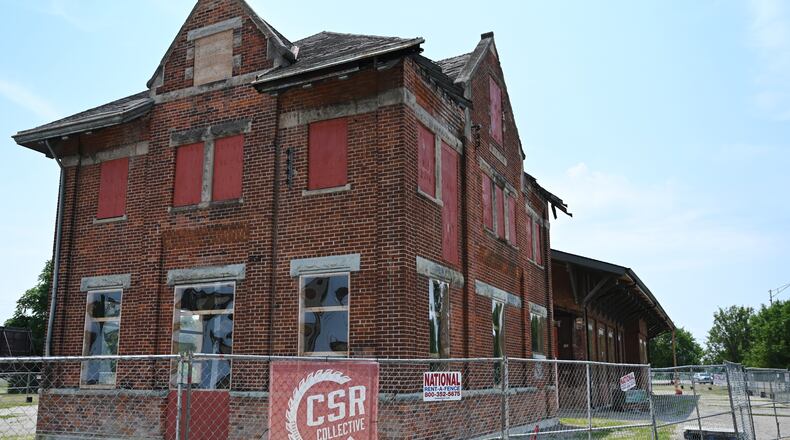“We envision the train depot serving as a key development anchor at the gateway to the Maple Avenue corridor, a significant focus area in Hamilton,” said Hamilton Chief of Staff Mallory Greenham. “Initial interest in the building has been promising, and we expect this interest to grow as stabilization progresses.”
Hamilton City Council in 2021 voted to save the historic depot, which was built in the 19th century by the Cincinnati, Hamilton and Dayton Railroad. It was an important portal for the city’s business community as thousands used the rail before interstates and air travel became the norm for travel.
It also served as a gateway for the young men of Butler County who rode off to serve in the Civil War through the Korean Conflict, Greenham said, adding the historic train depot also saw traveling presidents use this stop, including Harry S. Truman, Dwight D. Eisenhower, Theodore Roosevelt, Franklin D. Roosevelt, Herbert Hoover and Abraham Lincoln.
Before Hamilton City Council’s decision to save the depot, there was talk dating back to the 1970s on the future of the building, and city staff reported there have been communications from 1996, 2001 and 2012 urging Hamilton to preserve the train buildings.
The 2021 plan to prevent the imminent demolition by CSX required a heavy logistical lift ― figuratively and literally. The salvage of the building required its relocation from the ground owned by the railroad company to a city-owned parcel.
Credit: Michael D. Pitman
Credit: Michael D. Pitman
In December 2022 and then a month later in January 2023, Wolfe House and Building Movers relocated the 220-ton two-story and 330-ton one-story buildings 1,000-plus feet north to the corner of Maple Avenue and Martin Luther King Jr. Boulevard.
Once the buildings were relocated to the new foundation, work on stabilizing and securing against further deterioration began, which started with the roof. Part of the $2 million authorized by City Council will pay for the roof replacement, but nearly all of that money has either been spent or allocated.
Before the roof can be repaired, the new roof supports inside need to be installed, and that will be paid for with grant funding as City Council is not ready to authorize any more funding for the building’s restoration at this time.
A couple of grants, $150,000 from the Hamilton Community Foundation and $10,000 from Historic Hamilton will help get many of the immediate repairs, such as new floors for the attic and the second story, debris removal, bird abatement, and brick wall repairs.
Hamilton Director of Engineering Rich Engle previously told the council this additional work was discovered ahead of the start of the new roof installation.
Engel said there is not much more funding remaining from that initial $2 million budget, but what has been accomplished, among other things, includes: salvaging the historic elements before the move, including tin ceilings and windows; relocating the buildings and new foundations; installing temporary plexiglass windows and painted plywood windows; restorating exterior brick walls on both buildings; installing the new roof on the single-story building, along with installing new wood fascia, raking and soffit.
Credit: Journal News
Hamilton Community Foundation President and CEO John Guidugli said they were more than willing to support this project.
“I think you can see the city has taken this on as a very serious project,” he said.
The importance of the project is why Historic Hamilton also contributed funds.
“We’re proud to be able to support all the various efforts in the community to improve our economy but to also maintain that historical nature that is so important in Hamilton,” said Cynthia Stever of Historic Hamilton’s $10,000 contribution with the hope “to be a catalyst to raise funds for the restoration of the train station.”
“We’re very proud of the fact the train station has been moved up the street and is integral to the city,” she said. “We’re hoping that others will contribute to this fund for this train station restoration.”
Guidugli said the Hamilton Community Foundation has a fund ― Hamilton CSX Train Station Fund ― to accept donations for the project.
The goal for the city is to get it whiteboxed or leased, and to get it to that point, more grant funding and/or community financial support is needed.
Additional improvements needed beyond the current grant funds would support include: the installation of electrical, plumbing and HVAC in both buildings; the construction of a parking lot; interior finishing of all walls; repair and replacement of tin ceilings in both buildings; construction of concrete slab floors in both buildings; and installing windows and tuckpointing the exterior brick walls.
“They’ve made a lot of progress on it,” Guidugli said. “It just needs a few more things to reach the finish line.”
Credit: Michael D. Pitman/Staff
About the Author


